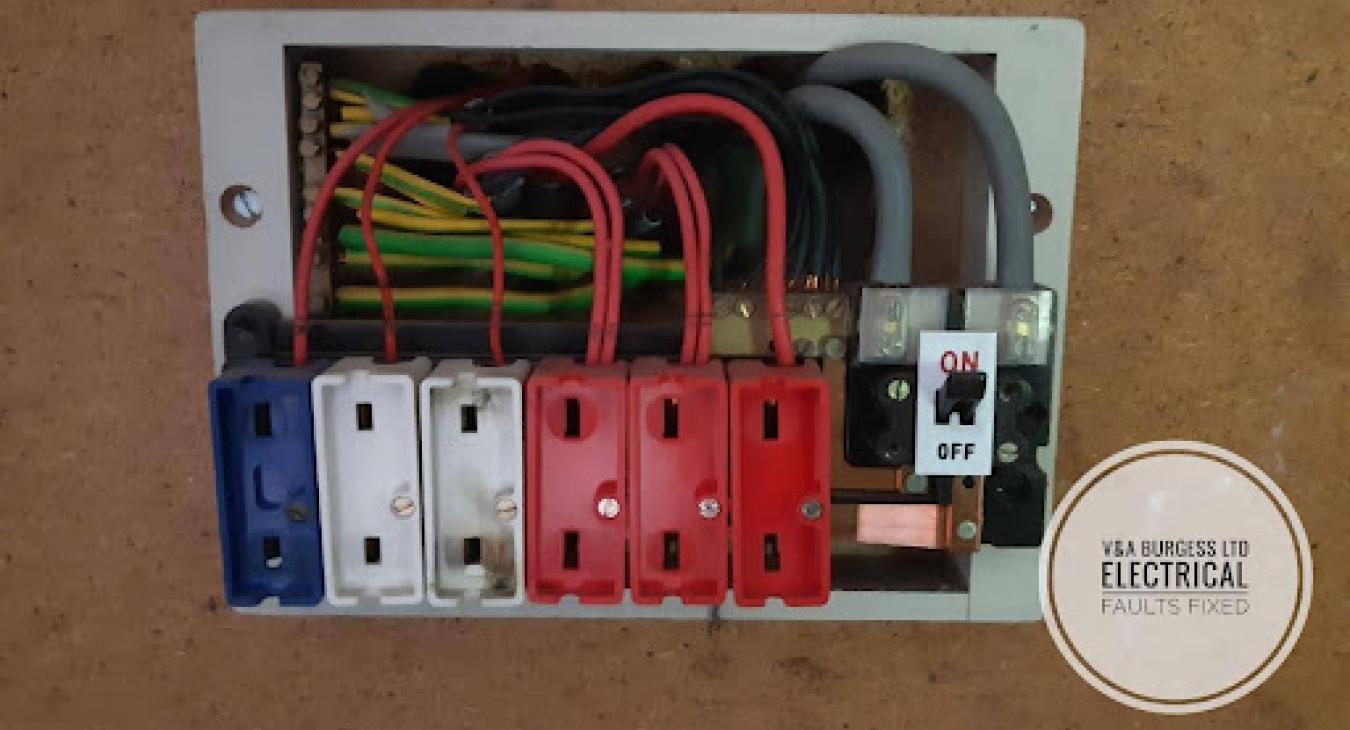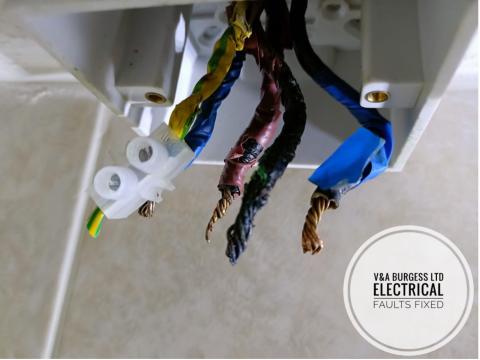
Table of Contents
- Can you install a new consumer unit with old wiring? We are going to look at the pros & cons of this & why it might be a BAD IDEA!
- What is a Consumer Unit?
- What is a Fuse Box?
- How are a Consumer Unit & a Fuse Box Different?
- How Old is Old Wiring?
- New Consumer Unit, Old wiring: Problems?
- WHY COULD IT BE EXPENSIVE??
- What is a Split Load Consumer Unit?
- What is a Dual RCD consumer unit?
- Common Questions
- Exceptions???
1) Can you install a new consumer unit with old wiring? We are going to look at the pros & cons of this & why it might be a BAD IDEA!
First let’s look at some background and get up to speed on what we are talking about!
Back to top2) What is a Consumer Unit?
A consumer unit (CU) is the electrical box that receives the incoming mains power supply and splits it up into electrical circuits for distribution around the home. We can see a consumer unit in the picture above. Some larger homes will have more than one consumer unit for instance a garage consumer unit to supply the electrical requirements of the garage.
The main consumer unit for the property is generally right next to the incoming mains supply and will have a dedicated circuit breaker (trip switch) for the supply to each of the other consumer units in the property. A consumer unit is often referred to as any of the following:
- Electrical Panel
- Fuse Box
- Fuse Board
- Distribution Board
- Trip Switch Box
But they generally all mean the same thing with subtle differences between the fuse box and consumer unit which we will look at. The important thing to remember with all these different names for the consumer unit is that its job is to protect against short circuit, earth fault and fatal electric shock.
Back to top3) What is a Fuse Box?
A fuse box is an older style of consumer unit that contains either fuses or piece of fuse wire held in a fuse wire carrier. This type of old fuse board is likely to have old wiring and whilst it may have complied with wiring regulations at the time it was installed it is unlikely to comply with current regulations today.
These old fuse boxes also did not offer RCD (residual current device) / RCCB (Residual Current Circuit Breaker) protection meaning that whilst a circuit may trip or a fuse may blow under the right conditions, there was no protection from earth leakage. Earth leakage is a low enough electrical current flow that a fuse will not blow nor miniature circuit breaker trip BUT a person may receive a fatal electric shock and the electrical system will continue to allow current to flow through the circuit breakers!
Back to top4) How are a Consumer Unit & a Fuse Box Different?
The difference technically is, fuses or fuse wire contained in the old style fuse box and trip switches in the consumer unit.
They both aim to perform the same functions but the new consumer unit does it better and offers more features such as protection from electrical fires, shocks, burns, arcing and electrical surges that would damage equipment.
Back to top5) How Old is Old Wiring?
In the UK, the wiring colours changed in 2004 to Brown and Blue from Red and Black. This means that if your wiring is Red and Black then is is at least 20 years old at the time of writing (the year 2024).
That is not to say that your older property needs new wiring any time soon but is more of an indication of the age of the existing installation. Before considering a rewire of an electrical installation it is a good idea to have a qualified electrician come and carry out a periodic electrical inspection. This inspection will produce an electrical installation condition report detailing any issues that need attention.
(An old Fuse Box with Old Wiring Colours)
During the inspection, the electrician will check the operation of the RCD (if you have one), the electrical wiring, the earth wires, the light fittings, light switches, the plug sockets and in fact will carry out testing on each of the different circuits. They will also check the existing consumer unit and protective devices (trip switches) to see if a consumer unit replacement is necessary or maybe simply a newer RCD device may suffice.
If Electrical work is required in order to bring the installation up to modern standards, then the electrician will highlight the first step in order to achieve this. It may be for example that a new CU is required in order to meet the high standard set out by the wiring regulations.
Back to top6) New Consumer Unit, Old wiring: Problems?
- Old Technology – When old technology protects a wiring system it does not detect many kinds of electrical faults and won’t offer the best form of protection.
- New Technology – Brand new technology in modern fuse boxes / units is FAR MORE sensitive than in older units and will pick up on many more electrical wiring issues than the old fuse boxes could.
- Existing Faults – Unfortunately as an old Fusebox doesn’t pick up on many faults, installing a new fuse box or modern fuse box on to the older wiring is likely to detect many issues that lay previously undiscovered. It is for MAINLY THIS PURPOSE than an electrical inspection should be considered before a fuse box replacement.
- Wiring Regulations – There can be many issues with the installation of a new kitchen for example. When a kitchen replacement is carried out, the existing installation and electrical wiring is often not sufficient for the new demands placed upon it. A replacement consumer unit must be installed before any new electrical work can be carried out as the old installation will not comply with the current wiring regulations.
- Switching on – If all advice is ignored and a replacement consumer unit is installed without testing beforehand then it is possible that switching on may prove impossible due to existing faults. Each of the separate circuits may have problems with the neutral wire being shared between them for example which is common in an old house. This is something that older consumer units may have missed but a new consumer unit would detect.
7) WHY COULD IT BE EXPENSIVE??
“Installing a brand-new consumer unit onto old wiring will highlight any hidden faults. This could mean an expensive rewire is needed, an expense that WAS NOT PLANNED FOR!”
Back to top8) What is a Split Load Consumer Unit?
A split load consumer unit was installed under the 16th Edition of the wiring regulations BS7671 (1991-2008). The consumer unit contains two separate sections within the consumer unit itself. The ‘power’ circuits such as sockets, cooker, shower, ring main (ring final) were protected by RCD generally. The lighting circuits and often alarm was NOT protected by RCD. The mains reason for this was to provide electric shock protection for socket outlets and other circuits that were likely to introduce danger through their general use whilst leaving lights separate. This meant that in the event of a fault whilst most of the electrical installation would be shut off the lights would remain ON.
The photograph below shows a split load consumer unit where there was an electrical fault affecting the circuits installed on the left-hand side of the consumer unit and protected by RCD.
(A Split Load Consumer Unit)
Back to top9) What is a Dual RCD consumer unit?
Introduced under the 17th Edition of BS7671 (2008-2018). These consumer units started out as plastic and then swapped to metal construction under amendment 3 (2015). The Dual RCD meant that generally ALL circuits including lighting circuits were afforded additional protection against electric shock by RCD.
These units are generally still compliant today although many have issues addressing excessive earth leakage currents which often result in unwanted tripping and inconvenience in the event of a fault as the power supply to several circuits at once is cut when there is an earth fault issue.
Back to top10) Common Questions
10.1) Why do we need a Garage Consumer Unit?
Sometimes it is preferable to have a separate unit for the garage in order to have individual circuits for the lights and sockets out there. This is preferable to prevent unwanted tripping in the main consumer unit in the house and to allow each individual circuit its own trip switch. This minimises inconvenience in the event of a circuit trip.
10.2) What are Consumer Units Constructed From?
The modern consumer unit is constructed from non-combustible material (normally metal) whereas the older consumer units were constructed from plastic, infrequently steel and sometimes Bakelite with wooden backing!
A new property will only have an electrical system constructed to the highest standards, compliant with part p of the building regulations and contain modern units compliant with all wiring regulations.
When a Fusebox replacement is carried out in an existing property the right consumer unit must be selected by the electrician carrying out the board change. The old consumer unit often has the main earth wire replaced and the mains power cables from the meter as these are often undersized.
10.3) Do Electrical Appliances Dictate the Type of Consumer Unit?
Certain electrical appliances are not suitable for use with older fuse boxes and the manufacturer’s instructions may dictate that a newer RCD is installed in order to provide the right protection in the event of a fault.
10.4) Metal Consumer Units or a Plastic Consumer Unit?
What type of consumer unit do we want? What is the current legal requirement?
These days (2024), all consumer units installed must be constructed to the latest version of the wiring regulations which states a non-combustible material must be used. Plastic units are no longer acceptable although DO NOT have to be changed for metal unless there are signs of damage.
10.5) Can New Circuits be Connected to Old Wiring?
In recent years RCD protection has become mandatory for any new system installed. Attaching new wire or additional electrical points onto an old wiring system will mean that the existing system MUST comply with the new wiring regulations.
The main reason for this is to ensure that safety is not compromised and to ensure that systems are updated to the highest standard at that time.
When carrying out these update works to old wiring, electrical issues can surface such as loose connections, broken neutral conductors or other Ring Final Circuit conductors and more. Whilst a full rewire of an older wiring system may not be necessary in order to attach new circuits or additional wiring on to old circuits, it is a good idea to speak with your electrician about the condition of your home wiring.
10.6) What happens if a new consumer unit cannot be fitted?
There are two ways to go about installing a new consumer unit.
- The electrician installs the new consumer unit and carries out the testing and inspection works on the existing installation as they go. No pre-testing is carried out in the form of a periodic inspection and Electrical Installation Condition Report (EICR).
- The Electrician carried out a prior Periodic Electrical Inspection and produces an Electrical Installation Condition Report highlighting any defects that require rectification.
Option 1 is possibly cheaper but could mean that faulty in the wiring system identified during testing mean that the new consumer unit cannot be turned on either partially or fully and some circuits may have to remain disconnected until the faults on the wiring have been found, fixed, or bypassed.
Option 2 is usually a little more costly but recommended so that any electrical issues can be discovered in advance and rectified (or not) and the new unit installed (or not).
Carrying out pre testing before attempting to install a NEW CONSUMER UNIT WITH OLD WIRING is highly recommended in the majority of circumstances as this allows the electrician to have a conversation with the customer regarding issues in the wiring system. Without the pre-inspection, the risk is that the electrical installation may be found to be dangerous and power cannot be reinstated until issues have been fixed.
In extreme cases where a wiring system is very old, a full rewire of the electrical system along with consumer unit replacement will be necessary in order to update the electrics. It is best to know if this is going to be the case.
Back to top11) Exceptions???
The newer the wiring system in the property, GENERALLY SPEAKING, the less likely there are to be problems and the pre-inspection could possibly be avoided but with the risk sitting with the customer regarding any electrical issues preventing the system from being re-energised.
Back to top









